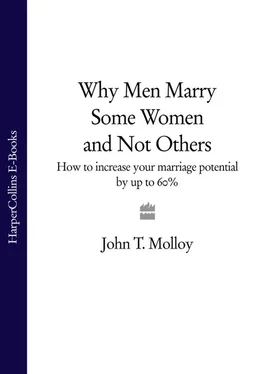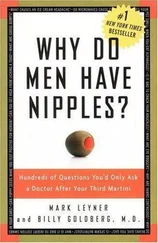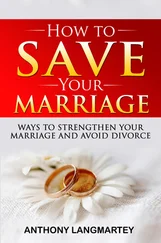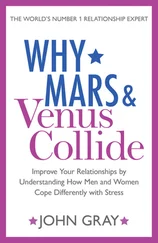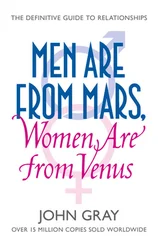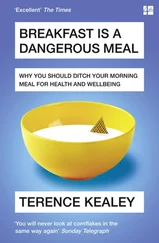WHY MEN MARRY SOME WOMEN AND NOT OTHERS
JOHN T. MOLLOY

Dedication Dedication Introduction 1. The Marrying Kind 2. First Impressions 3. Women Men Marry 4. The Stages in a Relationship 5. Speaking of Marriage 6. Marrying After Forty 7. Widowed and Divorced Men: Handle with Care 8. Meeting Online Conclusion: Defending Marriage Acknowledgments Also by the Author Copyright About the Publisher
This book, along with everything else I do, is dedicated to Maureen and Rob
Cover
Title Page WHY MEN MARRY SOME WOMEN AND NOT OTHERS JOHN T. MOLLOY
Dedication Dedication Dedication Introduction 1. The Marrying Kind 2. First Impressions 3. Women Men Marry 4. The Stages in a Relationship 5. Speaking of Marriage 6. Marrying After Forty 7. Widowed and Divorced Men: Handle with Care 8. Meeting Online Conclusion: Defending Marriage Acknowledgments Also by the Author Copyright About the Publisher This book, along with everything else I do, is dedicated to Maureen and Rob
Introduction Introduction Any single woman who lets the research in this book be her guide has not only a better chance of marrying, but also a better chance of marrying the man she truly desires. I personally oversaw the studies on which the text is based and used the same team that has been conducting dress, image, and sales research for Fortune 500 corporations and government agencies, both here and abroad, for more than forty years. This book is not a set of rules on how to manipulate a man into marriage. Rather, it’s designed to provide women with valid statistical information that will help them make intelligent decisions in their search for that special man. The first reason I believe this book will help women looking to switch their status from single to married is that its conclusions are based on thorough research. We interviewed, among others, 2,543 women and their fiancés coming out of marriage license bureaus, as well as 221 women in their late thirties and 463 in their forties who had no immediate prospects of marriage. We found that these two groups of women had different attitudes toward love, marriage, and life. We also discovered that unmarried women over forty had treated the men in their lives in a markedly different manner than the women who married in their twenties and early thirties. In addition, we sought information from some specific groups: men who went with one woman for years and immediately after breaking up with her married another; women who let others talk them out of marrying; men who had long-term relationships with one woman after another but never married; men who thought of themselves as confirmed bachelors; and so forth. Naturally, we ran focus groups anytime our interviews left questions unanswered or raised additional questions. The second reason I believe this book will help women marry is that, during the last eleven years, between three hundred and four hundred single female researchers worked on the project or became familiar with the research, and more than half of them married within three years. Since 19 percent of these women were in their late thirties or early forties and many had virtually given up on the idea of marrying, this is an extraordinarily high number. Finally, many of the very intelligent women who worked on the project believed the research helped them. I know, because scores of them thanked me personally and/or invited me to their weddings.
1. The Marrying Kind
2. First Impressions
3. Women Men Marry
4. The Stages in a Relationship
5. Speaking of Marriage
6. Marrying After Forty
7. Widowed and Divorced Men: Handle with Care
8. Meeting Online
Conclusion: Defending Marriage
Acknowledgments
Also by the Author
Copyright
About the Publisher
Any single woman who lets the research in this book be her guide has not only a better chance of marrying, but also a better chance of marrying the man she truly desires. I personally oversaw the studies on which the text is based and used the same team that has been conducting dress, image, and sales research for Fortune 500 corporations and government agencies, both here and abroad, for more than forty years.
This book is not a set of rules on how to manipulate a man into marriage. Rather, it’s designed to provide women with valid statistical information that will help them make intelligent decisions in their search for that special man.
The first reason I believe this book will help women looking to switch their status from single to married is that its conclusions are based on thorough research. We interviewed, among others, 2,543 women and their fiancés coming out of marriage license bureaus, as well as 221 women in their late thirties and 463 in their forties who had no immediate prospects of marriage. We found that these two groups of women had different attitudes toward love, marriage, and life. We also discovered that unmarried women over forty had treated the men in their lives in a markedly different manner than the women who married in their twenties and early thirties. In addition, we sought information from some specific groups: men who went with one woman for years and immediately after breaking up with her married another; women who let others talk them out of marrying; men who had long-term relationships with one woman after another but never married; men who thought of themselves as confirmed bachelors; and so forth. Naturally, we ran focus groups anytime our interviews left questions unanswered or raised additional questions.
The second reason I believe this book will help women marry is that, during the last eleven years, between three hundred and four hundred single female researchers worked on the project or became familiar with the research, and more than half of them married within three years. Since 19 percent of these women were in their late thirties or early forties and many had virtually given up on the idea of marrying, this is an extraordinarily high number.
Finally, many of the very intelligent women who worked on the project believed the research helped them. I know, because scores of them thanked me personally and/or invited me to their weddings.
The study was born in the late 1980s when Robin, a researcher I had hired to help me with a survey for a San Francisco firm, called and told me she could not show up the next day. She was calling from her older sister’s place. As it happened, I knew Robin’s sister, Kelly; she had worked for me as a researcher a few years earlier. Apparently, Kelly had just found out that a man she had dated for almost three years and broken up with five months earlier was marrying another woman. Robin said Kelly was so upset she couldn’t leave her and even hinted that Kelly might be suicidal. Then she added, “It’s partially your fault.” Of course, I asked how it could be my fault.
Robin told me it wasn’t the first time this had happened to her sister. Kelly had gone out with another man for two years, and a year after he had broken up with her, he had married someone else. While Kelly was working for me as a researcher, Robin reminded me, I had said over and over: If an event repeats itself, there’s usually a reason for it . Then without another word, Robin hung up.
Читать дальше
